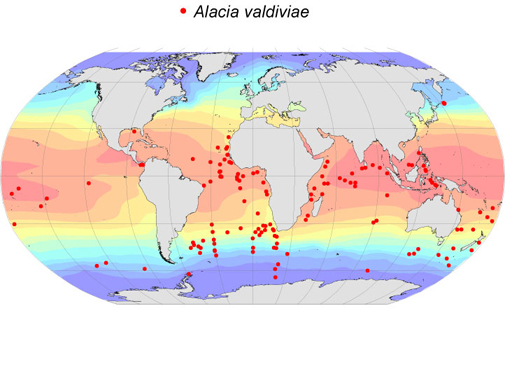Atlas of Atlantic Ostracods
Taxon details
Alacia valdiviae (Müller, G.W., 1906)
- Order:
- MYODOCOPA
- Suborder:
- Halocypridina
- Family:
- Halocyprididae
- Subfamily:
- Conchoecinae
- Size range (females):
- 5.1-6.0 mm
- Size range (males):
- 4.9-5.6 mm
- Depth:
- meso-/bathypelagic
Notes
Records: 147
One of the largest halocyprid species that lives at deep mesopelagic to bathypelagic depths. Live adults are immediately identifiable by their large size and bright red coloration (see Muller's 1906 colour plate and the title page of this atlas). Muller (1906) tentatively placed it in his “alata group” of species because it has lateral glands on the posterior margin of both carapace valves. Poulsen (1973, p.195) included all these species in his new genus Alacia and produced a summary of the numbers of glands on each valve in each of species. He comments that these glands are ‘the only decisive character for the genus’, which suggests that the genus is a heterogeneous assemblage of species. valdiviae has an extensive latitudinal range and may be associated with Antarctic Intermediate Water (Fasham and Angel, 1975). However, there are wide variations in carapace length; Southern Ocean specimens are smaller than those from tropical latitudes, and Poulsen (1973) reported that specimens from the Eastern Tropical Pacific are the largest. These size variations suggest that a critical re-evaluation may reveal presence of cryptic species.
| Southern Ocean | n | Mean mm | span | Range mm |
|---|---|---|---|---|
| Female | 109 | 5.39 | 0.133 | 5.08-5.58 |
| Male | 60 | 5.03 | 0.109 | 4.92-5.33 |
| A-1 | 46 | 3.75 | 0.085 | 3.60-3.92 |
| A-2 | 23 | 2.56 | 0.068 | 2.44-2.68 |
| Tropical Atlantic | n | Mean mm | span | Range mm |
|---|---|---|---|---|
| Female | 20 | 5.80 | 0.119 | 5.58-6.00 |
| Male | 16 | 5.47 | 0.082 | 5.25-5.58 |
| A-1 | 28 | 3.88 | 0.084 | 3.68-4.08 |
| A-2 | 34 | 2.55 | 0.067 | 2.44-2.68 |
| A-3 | 42 | 1.75 | 0.064 | 1.60-1.86 |
| A-4 | 9 | 1.15 | 0.054 | 1.04-1.24 |



